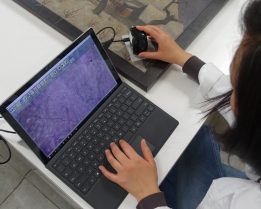We’ve Expanded Our Array of Examination Equipment

In the past few months, we acquired two new examination tools: a full-spectrum camera that allows for infra-red and ultraviolet reflectography and a microscope for examinations under normal, UV and IR light that can be viewed and adjusted on a computer. This equipment augments our magnification tools such as our operating microscope and our ultraviolet examination tools. We also use various lighting methods (reflected, transmitted, raking) to reveal various conditions on paintings, paper and objects.
A special full-spectrum camera has a filter which can capture a wide range of wavelengths, including ultraviolet (365nm) and infrared (700nm and up). Using different external filters on the camera lens we can take photographs that utilize the three types of light. We can adjust these images on our imaging software, and analyze differences between the images to discern qualities of pigments, dyes or other medias. This allows our conservators to reveal images below the surface of an artwork, an archival document or an object.
Infrared reflectography is extremely useful in non-invasive examination and can reveal hidden under drawings or changes made to the work, allowing conservators to better understand the work historically and find the best way for it to be treated. Sometimes changes are made to a work of art by an artist as part of the working process, and sometimes changes are accidental or are done as forgeries or restorations. This article from Metal Floss shows some very good examples of how examination equipment can reveal alterations. In particular, the painting by Picasso (Image 2), was analyzed with IR reflectography.
We were able to put our new IR examination equipment to good use to help a private art collector discover an original artist signature on an early painting by famed Canadian Group of Seven artist, Lawren Harris. There were two signatures on the bottom of the painting, one that was clearly visible in a black media and another older signature that had been partly rubbed away by the artist and then obscured by a stroke of green oil paint. Paintings conservator, Emily Min, initially used our mini microscope with IR filtration to discern whether there was more to the signature, before we investigated further. She then viewed the signature under lighting on the full-spectrum camera for better resolution, clearly revealing the complete signature [L. S. Harris]! It is not uncommon for Lawren Harris to have removed signatures and double-signed works. In this case, he very likely partially removed an older signature before signing the work again at a later date.


The image of the full initials and signature of Lawren Harris under his green oil paint stroke is revealed if you click and grab the center slider, moving it from right to left.
